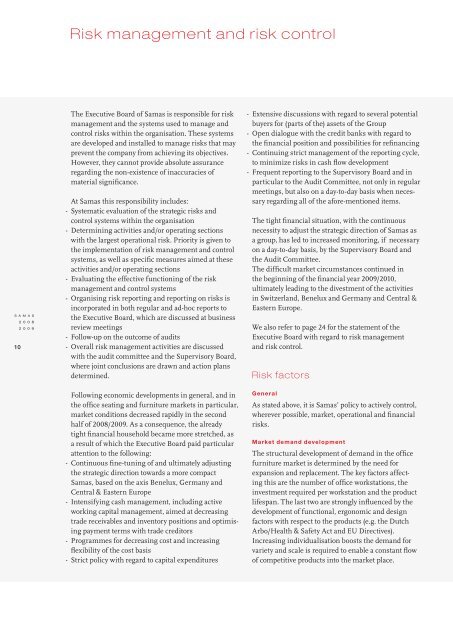Annual Report Samas NV 2008 2009 Annual ... - Alle jaarverslagen
Annual Report Samas NV 2008 2009 Annual ... - Alle jaarverslagen
Annual Report Samas NV 2008 2009 Annual ... - Alle jaarverslagen
- No tags were found...
You also want an ePaper? Increase the reach of your titles
YUMPU automatically turns print PDFs into web optimized ePapers that Google loves.
Risk management and risk controlS a m a s2 0 0 82 0 0 910The Executive Board of <strong>Samas</strong> is responsible for riskmanagement and the systems used to manage andcontrol risks within the organisation. These systemsare developed and installed to manage risks that mayprevent the company from achieving its objectives.However, they cannot provide absolute assuranceregarding the non-existence of inaccuracies ofmaterial significance.At <strong>Samas</strong> this responsibility includes:- Systematic evaluation of the strategic risks andcontrol systems within the organisation- Determining activities and/or operating sectionswith the largest operational risk. Priority is given tothe implementation of risk management and controlsystems, as well as specific measures aimed at theseactivities and/or operating sections- Evaluating the effective functioning of the riskmanagement and control systems- Organising risk reporting and reporting on risks isincorporated in both regular and ad-hoc reports tothe Executive Board, which are discussed at businessreview meetings- Follow-up on the outcome of audits- Overall risk management activities are discussedwith the audit committee and the Supervisory Board,where joint conclusions are drawn and action plansdetermined.- Extensive discussions with regard to several potentialbuyers for (parts of the) assets of the Group- Open dialogue with the credit banks with regard tothe financial position and possibilities for refinancing- Continuing strict management of the reporting cycle,to minimize risks in cash flow development- Frequent reporting to the Supervisory Board and inparticular to the Audit Committee, not only in regularmeetings, but also on a day-to-day basis when necessaryregarding all of the afore-mentioned items.The tight financial situation, with the continuousnecessity to adjust the strategic direction of <strong>Samas</strong> asa group, has led to increased monitoring, if necessaryon a day-to-day basis, by the Supervisory Board andthe Audit Committee.The difficult market circumstances continued inthe beginning of the financial year <strong>2009</strong>/2010,ultimately leading to the divestment of the activitiesin Switzerland, Benelux and Germany and Central &Eastern Europe.We also refer to page 24 for the statement of theExecutive Board with regard to risk managementand risk control.Risk factorsFollowing economic developments in general, and inthe office seating and furniture markets in particular,market conditions decreased rapidly in the secondhalf of <strong>2008</strong>/<strong>2009</strong>. As a consequence, the alreadytight financial household became more stretched, asa result of which the Executive Board paid particularattention to the following:- Continuous fine-tuning of and ultimately adjustingthe strategic direction towards a more compact<strong>Samas</strong>, based on the axis Benelux, Germany andCentral & Eastern Europe- Intensifying cash management, including activeworking capital management, aimed at decreasingtrade receivables and inventory positions and optimisingpayment terms with trade creditors- Programmes for decreasing cost and increasingflexibility of the cost basis- Strict policy with regard to capital expendituresGeneralAs stated above, it is <strong>Samas</strong>’ policy to actively control,wherever possible, market, operational and financialrisks.Market demand developmentThe structural development of demand in the officefurniture market is determined by the need forexpansion and replacement. The key factors affectingthis are the number of office workstations, theinvestment required per workstation and the productlifespan. The last two are strongly influenced by thedevelopment of functional, ergonomic and designfactors with respect to the products (e.g. the DutchArbo/Health & Safety Act and EU Directives).Increasing individualisation boosts the demand forvariety and scale is required to enable a constant flowof competitive products into the market place.

















